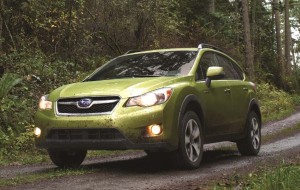Subaru, the brand that helped popularize all-wheel-drive, is now trying its hand at hybrids.
The Japanese automaker unveiled its first-ever production gas-electric model, the Subaru XV Crosstrek Hybrid, at its 2013 New York International Auto Show press preview.
The official unveiling comes barely a month after the Japanese maker revealed a plug-in hybrid concept, the DIZIV, at the Geneva Motor Show. The two announcements could signal that Subaru sees some serious opportunities going forward in alternative propulsion.
For its first-ever production hybrid, however, Subaru is opting for fairly conventional technology – even forgoing the more advanced lithium-ion battery technology that some competitors are migrating to, sticking with more time-tested and lower-cost nickel-metal hydride power.
Based on the gas-powered Crosstrek CUV, the XV Hybrid utilizes a 148-horsepower 2.0-liter Subaru Boxer engine producing 145 pound-feet of torque paired with an electric motor making 13.4-hp and 48 lb-ft. Both power sources are integrated into a Lineartronic continuously variable transmission.
The electric motor is mounted just behind the transmission, while the 100-volt, 13.5 kilowatt nickel-metal hydride battery pack is located under a revised rear floor area. Overall, the compact hybrid system weighs just 209 pounds.
There’s only a modest sacrifice in cargo space due to the battery pack, the hybrid rated at 50.2 cubic feet compared to 51.9 for the gas-powered XV Crosstrek.
The system is expected to deliver 28 mpg in the City, 34 on the Highway and 31 Combined, according to EPA ratings.
Under light acceleration, the Subaru-engineered hybrid system uses the electric motor for initial vehicle acceleration and then starts the gasoline engine once underway. The electric motor can also provide motor assist for acceleration in parallel with the gasoline engine, and an EV mode will operate the vehicle in certain low-speed situations for brief distances.
The Crosstrek Hybrid shares the gasoline model’s Symmetrical All-Wheel Drive and chassis capability. For example, the crossover’s 8.7 inches of ground clearance is the same as for the gas model — but is higher than for some dedicated SUVs, while providing a low step-in height.
Subaru also re-engineered the chassis to handle the added weight of the battery system, improving handling, steering and ride, the maker notes.
In addition to chassis changes, the XV Crosstrek Hybrid added extra sound insulation, a start/stop feature, a revised, low-energy climate control system, a new gauge cluster, keyless start and numerous other changes. The Color Multi-Function Display shows the hybrid system’s energy flow according to driving conditions.
The decision to launch the Subaru XV Crosstrek Hybrid so soon after the preview of the DIZIV concept has created a bit of confusion, several company insiders acknowledge. But, at least for now, it appears the DIZIV plug-in has no actual place in the Subaru production plans. But it could illustrate what the maker is thinking about when it comes to a more advanced battery drive system for the future.
The DIZIV relied on three electric motors in a system Subaru dubbed SI-Drive. The one up front handled both powering the front axle and also could regenerate power during braking. The two rear motors powered the back axle but could not serve regenerative duties.

